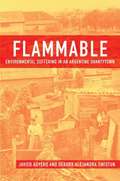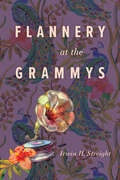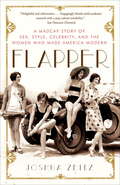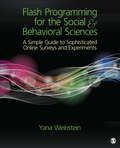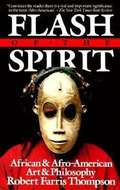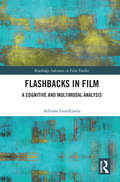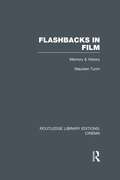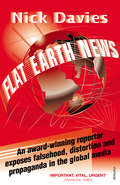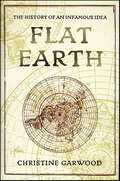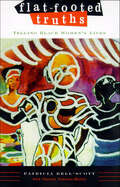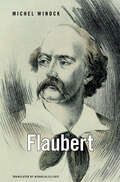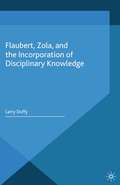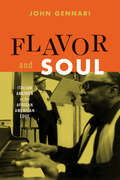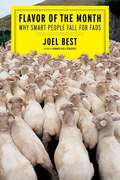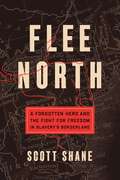- Table View
- List View
Flammable: Environmental Suffering in an Argentine Shantytown
by Javier Auyero Debora Alexandra SwistunThis collaborative ethnography vividly describes everyday life in Flammable--the dreadfully polluted shantytown in Buenos Aires--and depicts how this ongoing, slow-motion environmental disaster is experienced and understood by its residents.
Flannery at the Grammys
by Irwin H. StreightA devout Catholic, a visionary—and some say prophetic—writer, Flannery O’Connor (1925–1964) has gained a growing presence in contemporary popular culture. While O’Connor professed that she did not have an ear for music, allusions to her writing appear in the lyrics and narrative form of some of the most celebrated musicians on the contemporary music scene. Flannery at the Grammys sounds the extensive influence of this southern author on the art and vision of a suite of American and British singer-songwriters and pop groups. Author Irwin H. Streight invites critical awareness of O’Connor’s resonance in the products of popular music culture—in folk, blues, rock, gospel, punk, heavy metal, and indie pop songs by some of the most notable figures in the popular music business. Streight examines O'Connor's influence on the art and vision of multiple Grammy Award winners Bruce Springsteen, Lucinda Williams, R.E.M., and U2, along with celebrated songwriters Nick Cave, PJ Harvey, Sufjan Stevens, Mary Gauthier, Tom Waits, and others. Despite her orthodox religious, and at times controversial, views and limited literary output, O’Connor has left a curiously indelible mark on the careers of the successful musicians discussed in this volume. Still, her acknowledged influence and remarkable presence in contemporary pop and rock songs has not been well noted by pop music critics and/or literary scholars. Many years in the making, Flannery at the Grammys achieves groundbreaking work in cultural studies and combines in-depth literary and pop music scholarship to engage the informed devotee and the casual reader alike.
Flapper
by Joshua ZeitzBlithely flinging aside the Victorian manners that kept her disapproving mother corseted, the New Woman of the 1920s puffed cigarettes, snuck gin, hiked her hemlines, danced the Charleston, and necked in roadsters. More important, she earned her own keep, controlled her own destiny, and secured liberties that modern women take for granted. Her newfound freedom heralded a radical change in American culture.Whisking us from the Alabama country club where Zelda Sayre first caught the eye of F. Scott Fitzgerald to Muncie, Indiana, where would-be flappers begged their mothers for silk stockings, to the Manhattan speakeasies where patrons partied till daybreak, historian Joshua Zeitz brings the era to exhilarating life. This is the story of America's first sexual revolution, its first merchants of cool, its first celebrities, and its most sparkling advertisement for the right to pursue happiness.The men and women who made the flapper were a diverse lot. There was Coco Chanel, the French orphan who redefined the feminine form and silhouette, helping to free women from the torturous corsets and crinolines that had served as tools of social control. Three thousand miles away, Lois Long, the daughter of a Connecticut clergyman, christened herself "Lipstick" and gave New Yorker readers a thrilling entrée into Manhattan's extravagant Jazz Age nightlife.In California, where orange groves gave way to studio lots and fairytale mansions, three of America's first celebrities--Clara Bow, Colleen Moore, and Louise Brooks, Hollywood's great flapper triumvirate--fired the imaginations of millions of filmgoers.Dallas-born fashion artist Gordon Conway and Utah-born cartoonist John Held crafted magazine covers that captured the electricity of the social revolution sweeping the United States.Bruce Barton and Edward Bernays, pioneers of advertising and public relations, taught big business how to harness the dreams and anxieties of a newly industrial America--and a nation of consumers was born.Towering above all were Zelda and Scott Fitzgerald, whose swift ascent and spectacular fall embodied the glamour and excess of the era that would come to an abrupt end on Black Tuesday, when the stock market collapsed and rendered the age of abundance and frivolity instantly obsolete.With its heady cocktail of storytelling and big ideas, Flapper is a dazzling look at the women who launched the first truly modern decade.From the Hardcover edition.
Flapper
by Joshua ZeitzBlithely flinging aside the Victorian manners that kept her disapproving mother corseted, the New Woman of the 1920s puffed cigarettes, snuck gin, hiked her hemlines, danced the Charleston, and necked in roadsters. More important, she earned her own keep, controlled her own destiny, and secured liberties that modern women take for granted. Her newfound freedom heralded a radical change in American culture.Whisking us from the Alabama country club where Zelda Sayre first caught the eye of F. Scott Fitzgerald to Muncie, Indiana, where would-be flappers begged their mothers for silk stockings, to the Manhattan speakeasies where patrons partied till daybreak, historian Joshua Zeitz brings the era to exhilarating life. This is the story of America's first sexual revolution, its first merchants of cool, its first celebrities, and its most sparkling advertisement for the right to pursue happiness.The men and women who made the flapper were a diverse lot. There was Coco Chanel, the French orphan who redefined the feminine form and silhouette, helping to free women from the torturous corsets and crinolines that had served as tools of social control. Three thousand miles away, Lois Long, the daughter of a Connecticut clergyman, christened herself "Lipstick" and gave New Yorker readers a thrilling entrée into Manhattan's extravagant Jazz Age nightlife.In California, where orange groves gave way to studio lots and fairytale mansions, three of America's first celebrities--Clara Bow, Colleen Moore, and Louise Brooks, Hollywood's great flapper triumvirate--fired the imaginations of millions of filmgoers.Dallas-born fashion artist Gordon Conway and Utah-born cartoonist John Held crafted magazine covers that captured the electricity of the social revolution sweeping the United States.Bruce Barton and Edward Bernays, pioneers of advertising and public relations, taught big business how to harness the dreams and anxieties of a newly industrial America--and a nation of consumers was born.Towering above all were Zelda and Scott Fitzgerald, whose swift ascent and spectacular fall embodied the glamour and excess of the era that would come to an abrupt end on Black Tuesday, when the stock market collapsed and rendered the age of abundance and frivolity instantly obsolete.With its heady cocktail of storytelling and big ideas, Flapper is a dazzling look at the women who launched the first truly modern decade.From the Hardcover edition.
Flapper
by Joshua ZeitzBlithely flinging aside the Victorian manners that kept her disapproving mother corseted, the New Woman of the 1920s puffed cigarettes, snuck gin, hiked her hemlines, danced the Charleston, and necked in roadsters. More important, she earned her own keep, controlled her own destiny, and secured liberties that modern women take for granted. Her newfound freedom heralded a radical change in American culture.Whisking us from the Alabama country club where Zelda Sayre first caught the eye of F. Scott Fitzgerald to Muncie, Indiana, where would-be flappers begged their mothers for silk stockings, to the Manhattan speakeasies where patrons partied till daybreak, historian Joshua Zeitz brings the era to exhilarating life. This is the story of America's first sexual revolution, its first merchants of cool, its first celebrities, and its most sparkling advertisement for the right to pursue happiness.The men and women who made the flapper were a diverse lot. There was Coco Chanel, the French orphan who redefined the feminine form and silhouette, helping to free women from the torturous corsets and crinolines that had served as tools of social control. Three thousand miles away, Lois Long, the daughter of a Connecticut clergyman, christened herself "Lipstick" and gave New Yorker readers a thrilling entrée into Manhattan's extravagant Jazz Age nightlife.In California, where orange groves gave way to studio lots and fairytale mansions, three of America's first celebrities--Clara Bow, Colleen Moore, and Louise Brooks, Hollywood's great flapper triumvirate--fired the imaginations of millions of filmgoers.Dallas-born fashion artist Gordon Conway and Utah-born cartoonist John Held crafted magazine covers that captured the electricity of the social revolution sweeping the United States.Bruce Barton and Edward Bernays, pioneers of advertising and public relations, taught big business how to harness the dreams and anxieties of a newly industrial America--and a nation of consumers was born.Towering above all were Zelda and Scott Fitzgerald, whose swift ascent and spectacular fall embodied the glamour and excess of the era that would come to an abrupt end on Black Tuesday, when the stock market collapsed and rendered the age of abundance and frivolity instantly obsolete.With its heady cocktail of storytelling and big ideas, Flapper is a dazzling look at the women who launched the first truly modern decade.From the Hardcover edition.
Flapper: A Madcap Story of Sex, Style, Celebrity, and the Women Who Made America Modern
by Joshua ZeitzBlithely flinging aside the Victorian manners that kept her disapproving mother corseted, the New Woman of the 1920s puffed cigarettes, snuck gin, hiked her hemlines, danced the Charleston, and necked in roadsters. More important, she earned her own keep, controlled her own destiny, and secured liberties that modern women take for granted. Her newfound freedom heralded a radical change in American culture. Whisking us from the Alabama country club where Zelda Sayre first caught the eye of F. Scott Fitzgerald to Muncie, Indiana, where would-be flappers begged their mothers for silk stockings, to the Manhattan speakeasies where patrons partied till daybreak, historian Joshua Zeitz brings the era to exhilarating life. This is the story of America's first sexual revolution, its first merchants of cool, its first celebrities, and its most sparkling advertisement for the right to pursue happiness. The men and women who made the flapper were a diverse lot. There was Coco Chanel, the French orphan who redefined the feminine form and silhouette, helping to free women from the torturous corsets and crinolines that had served as tools of social control. Three thousand miles away, Lois Long, the daughter of a Connecticut clergyman, christened herself "Lipstick" and gave New Yorker readers a thrilling entrée into Manhattan's extravagant Jazz Age nightlife. In California, where orange groves gave way to studio lots and fairytale mansions, three of America's first celebrities--Clara Bow, Colleen Moore, and Louise Brooks, Hollywood's great flapper triumvirate--fired the imaginations of millions of filmgoers. Dallas-born fashion artist Gordon Conway and Utah-born cartoonist John Held crafted magazine covers that captured the electricity of the social revolution sweeping the United States. Bruce Barton and Edward Bernays, pioneers of advertising and public relations, taught big business how to harness the dreams and anxieties of a newly industrial America--and a nation of consumers was born. Towering above all were Zelda and Scott Fitzgerald, whose swift ascent and spectacular fall embodied the glamour and excess of the era that would come to an abrupt end on Black Tuesday, when the stock market collapsed and rendered the age of abundance and frivolity instantly obsolete. With its heady cocktail of storytelling and big ideas,Flapperis a dazzling look at the women who launched the first truly modern decade. From the Hardcover edition.
Flappers: Six Women of a Dangerous Generation
by Judith MackrellBy the 1920s, women were on the verge of something huge. Jazz, racy fashions, eyebrowraising new attitudes about art and sex—all of this pointed to a sleek, modern world, one that could shake off the grimness of the Great War and stride into the future in one deft, stylized gesture. The women who defined this the Jazz Age—Josephine Baker, Tallulah Bankhead, Diana Cooper, Nancy Cunard, Zelda Fitzgerald, and Tamara de Lempicka—would presage the sexual revolution by nearly half a century and would shape the role of women for generations to come.In Flappers, the acclaimed biographer Judith Mackrell renders these women with all the color that marked their lives and their era. Both sensuous and sympathetic, her admiring biography lays bare the private lives of her heroines, filling in the bold contours. These women came from vastly different backgrounds, but all ended up passing through Paris, the mecca of the avant-garde. Before she was the toast of Parisian society, Josephine Baker was a poor black girl from the slums of Saint Louis. Tamara de Lempicka fled the Russian Revolution only to struggle to scrape together a life for herself and her family. A committed painter, her portraits were indicative of the age's art deco sensibility and sexual daring. The Brits in the group—Nancy Cunard and Diana Cooper— came from pinkie-raising aristocratic families but soon descended into the salacious delights of the vanguard. Tallulah Bankhead and Zelda Fitzgerald were two Alabama girls driven across the Atlantic by a thirst for adventure and artistic validation.But beneath the flamboyance and excess of the Roaring Twenties lay age-old prejudices about gender, race, and sexuality. These flappers weren't just dancing and carousing; they were fighting for recognition and dignity in a male-dominated world. They were more than mere lovers or muses to the modernist masters—in their pursuit of fame and intense experience, we see a generation of women taking bold steps toward something burgeoning, undefined, maybe dangerous: a New Woman.
Flash Count Diary: Menopause and the Vindication of Natural Life
by Darcey Steinke“Many days I believe menopause is the new (if long overdue) frontier for the most compelling and necessary philosophy; Darcey Steinke is already there, blazing the way. This elegant, wise, fascinating, deeply moving book is an instant classic. I’m about to buy it for everyone I know.” —Maggie Nelson, author of The ArgonautsA brave, brilliant, and unprecedented examination of menopauseMenopause hit Darcey Steinke hard. First came hot flashes. Then insomnia. Then depression. As she struggled to express what was happening to her, she came up against a culture of silence. Throughout history, the natural physical transition of menopause has been viewed as something to deny, fear, and eradicate. Menstruation signals fertility and life, and childbirth is revered as the ultimate expression of womanhood. Menopause is seen as a harbinger of death. Some books Steinke found promoted hormone replacement therapy. Others encouraged acceptance. But Steinke longed to understand menopause in a more complex, spiritual, and intellectually engaged way.In Flash Count Diary, Steinke writes frankly about aspects of Menopause that have rarely been written about before. She explores the changing gender landscape that comes with reduced hormone levels, and lays bare the transformation of female desire and the realities of prejudice against older women. Weaving together her personal story with philosophy, science, art, and literature, Steinke reveals that in the seventeenth century, women who had hot flashes in front of others could be accused of being witches; that the model for Duchamp's famous Étant donnés was a post-reproductive woman; and that killer whales—one of the only other species on earth to undergo menopause—live long post-reproductive lives. Flash Count Diary, with its deep research, open play of ideas, and reverence for the female body, will change the way you think about menopause. It's a deeply feminist book—honest about the intimations of mortality that menopause brings while also arguing for the ascendancy, beauty, and power of the post-reproductive years.
Flash Programming for the Social & Behavioral Sciences: A Simple Guide to Sophisticated Online Surveys and Experiments
by Professor Yana WeinsteinAdobe Flash is one of the most popular languages for animated web content, and recently social and behavioral scientists have started to take advantage of it to collect data online. Flash Programming for the Social and Behavioral Sciences: A Simple Guide to Sophisticated Online Surveys and Experiments is a unique, step-by-step guide to using Adobe Flash to develop experiments and other research tools. Each chapter presents a set of techniques required for one aspect of programming an experiment, with students following instructions in italics and working through the code included in the text. Most chapters end with an exercise to put the newly learned techniques into practice.
Flash of the Spirit: African and Afro-American Art and Philosophy
by Robert Farris ThompsonThis book reveals how five distinct African civilizations have shaped the specific cultures of their New World descendants.
Flashback: Drugs and Dealing in the Golden Age of the London Rave Scene (Routledge Advances in Ethnography)
by Jennifer WardThis book is a detailed and close examination of the rave club drugs market as it took place in nightclubs, dance parties, pubs and bars and among friendship networks in London, in the mid to late 1990s. It focuses on the organizational features of drugs purchasing and selling and differentiates anonymous drugs trading in public nightclub settings, from selling among extended networks of friends and others. The stories of different people and friendship groups illustrate the varied drug selling roles and highlight the enterprise and entrepreneurship supporting their involvement. Told from the perspective of author's own membership in this night-time leisure culture, and embracing the disciplines of urban sociology and cultural criminology, this book contributes to our knowledge of recreational drugs markets and night-time leisure cultures. It will be of interest to students and academics with interests in these fields, as well as the many other people whose lives became a part of this vibrant leisure scene.
Flashbacks in Film: A Cognitive and Multimodal Analysis (Routledge Advances in Film Studies)
by Adriana GordejuelaFlashbacks in Film examines fi lm fl ashback as a rich multimodal narrative device, analyzing the cognitive underpinnings of fi lm fl ashbacks and the mechanisms that lead viewers to successfully comprehend them. Combining a cognitive fi lm theory approach with the theoretical framework proposed by blending theory, which claims that human beings’ general ability for conceptual integration underlies most of our daily activities, this book argues that fl ashbacks make sense to the viewer, as they are specifi cally designed for the viewer’s cognitive understanding. Through a mixture of analysis and dozens of case studies, this book demonstrates that successful fi lm fl ashbacks appeal to the spectator’s natural perceptual and cognitive abilities, which spectators exercise daily. This book will serve as a valuable resource for scholars interested in film studies, media studies, and cognitive linguistics.
Flashbacks in Film: Memory & History (Routledge Library Editions: Cinema)
by Maureen TurimThe flashback is a crucial moment in a film narrative, one that captures the cinematic expression of memory, and history. This author’s wide-ranging account of this single device reveals it to be an important way of creating cinematic meaning. Taking as her subject all of film history, the author traces out the history of the flashback, illuminating that history through structuralist narrative theory, psychoanalytic theories of subjectivity, and theories of ideology. From the American silent film era and the European and Japanese avant-garde of the twenties, from film noir and the psychological melodrama of the forties and fifties to 1980s art and Third World cinema, the flashback has interrogated time and memory, making it a nexus for ideology, representations of the psyche, and shifting cultural attitudes.
Flashes of Brilliance: The Genius of Early Photography and How It Transformed Art, Science, and History
by Anika BurgessThe story of the wildest experiments in early photography and the wild people who undertook them. Today it’s routine to take photos from an airplane window, use a camera underwater, or watch a movie or view an X-ray. But the photographic innovations more than a century ago that made such things possible were experimental, revelatory, and sometimes dangerous—and many of the innovators, entrepreneurs, and inventors behind them were memorable eccentrics. In Flashes of Brilliance, New York Times photo editor Anika Burgess engagingly blends art, science, and social history to reveal the most dramatic developments in photography from its birth in the 1830s to the early twentieth century. Writing with verve and and an eye for the compelling detail, Burgess explores how photographers uncovered new vistas, including dark caves and catacombs, cities at night, the depths of the ocean, and the surface of the moon. She describes how photographers captured the world as never seen before, showing for the first time the bones of humans, the motion of animals, the cells of plants, and the structure of snowflakes. She takes us on a tour of astonishing innovations, including botanist Anna Atkins and her extraordinary blue-hued cyanotypes and the world’s first photobook; Eadweard Muybridge and Étienne-Jules Marey’s famed experiments in capturing motion and their long legacy; the work of Nadar, Carleton E. Watkins, and other leading pioneers of large-scale photography; and aerial photography using balloons, kites, and pigeons. Burgess also delves into the early connections between photography and society that are still with us today: how photo manipulation—the art of “fake images”—was an issue right from the start; how the police used the telephoto lens to surveil suffragists and others; and how leading Black figures like Sojourner Truth and Frederick Douglass adapted self-portraits to assert their identity and autonomy. Richly illustrated and filled with fascinating tales, Flashes of Brilliance shows how the rise of a new art form transformed culture and our view of the world.
Flashpoints for Asian American Studies
by Cathy J. Schlund–Vials, EditorEmerging from mid-century social movements, Civil Rights Era formations, and anti-war protests, Asian American studies is now an established field of transnational inquiry, diasporic engagement, and rights activism. These histories and origin points analogously serve as initial moorings for Flashpoints for Asian American Studies, a collection that considers–almost fifty years after its student protest founding--the possibilities of and limitations inherent in Asian American studies as historically entrenched, politically embedded, and institutionally situated interdiscipline. Unequivocally, Flashpoints for Asian American Studies investigates the multivalent ways in which the field has at times and—more provocatively, has not—responded to various contemporary crises, particularly as they are manifest in prevailing racist, sexist, homophobic, and exclusionary politics at home, ever-expanding imperial and militarized practices abroad, and neoliberal practices in higher education.
Flat Earth News: An Award-winning Reporter Exposes Falsehood, Distortion and Propaganda in the Global Media
by Nick DaviesDoes ‘fake news’ really exist? Find out from the ultimate insider.After years of working as a respected journalist, Nick Davies, in this shocking exposé, reveals what really goes on behind the scenes of this contentious industry. From a prestigious newspaper that allowed intelligence agencies to plant fiction in its columns, to the newsroom that routinely rejected stories due to racial bias, to the number of papers that accepted cash bribes. Gripping, thought-provoking and revelatory, this is an insider’s look at one of the most tainted professions.‘Meticulous, fair-minded and utterly gripping’ Telegraph‘Powerful and timely...his analysis is fair, meticulously researched and fascinating’ Observer
Flat Earth: The History of an Infamous Idea
by Christine GarwoodContrary to popular belief fostered in countless school classrooms the world over, Christopher Columbus did not discover that the earth was round. The idea of a spherical world had been widely accepted in educated circles from as early as the fourth century B.C. Yet, bizarrely, it was not until the supposedly more rational nineteenth century that the notion of a flat earth really took hold. Even more bizarrely, it persists to this day, despite Apollo missions and widely publicized pictures of the decidedly spherical Earth from space. Based on a range of original sources, Garwood's history of flat-Earth beliefs---from the Babylonians to the present day---raises issues central to the history and philosophy of science, its relationship to religion and the making of human knowledge about the natural world. Flat Earth is the first definitive study of one of history's most notorious and persistent ideas, and it evokes all the intellectual, philosophical, and spiritual turmoil of the modern age. Ranging from ancient Greece, through Victorian England, to modern-day America, this is a story that encompasses religion, science, and pseudoscience, as well as a spectacular array of people and places. Where else could eccentric aristocrats, fundamentalist preachers, and conspiracy theorists appear alongside Copernicus, Newton, and NASA, except in an account of such a legendary misconception?Thoroughly enjoyable and illuminating, Flat Earth is social and intellectual history at its best.
Flat-Footed Truths: Telling Black Women's Lives
by Patricia Bell-ScottA new and exciting collection from Patricia Bell-Scott, the editor of the enormously successful Life Notes and the award-winning Double Stitch. With a foreword by Marcia Ann Gillespie.To tell the flat-footed truth is a southern saying that means to tell the naked truth. This revealing and inspiring anthology brings together twenty-seven creative spirits who through essays, interviews, poetry, and photographic images tell black women's lives. In the opening section that discusses the risks involved in sharing your life with others, Sapphire tells us about the challenges in recording her experiences when there has never been any validation that her life was important. The next section chronicles the adventure in claiming the lives of those who have been lost or neglected, such as Alice Walker's search for the real story of Zora Neale Hurston. The third part, which affirms lives of resistance, includes Audre Lorde's acclaimed essay "Poetry Is Not a Luxury." The final chapter, focusing on transformed lives, presents an insightful interview with Sonia Sanchez.This wonderful collection, featuring such writers as bell hooks, Barbara Smith, Marcia Ann Gillespie, and Pearl Cleage, is testimony to a flourishing literary tradition, filled with daring women, that will inspire others to tell their own stories.
Flatlining: Race, Work, and Health Care in the New Economy
by Adia Harvey WingfieldWhat happens to black health care professionals in the new economy, where work is insecure and organizational resources are scarce? In Flatlining, Adia Harvey Wingfield exposes how hospitals, clinics, and other institutions participate in “racial outsourcing,” relying heavily on black doctors, nurses, technicians, and physician assistants to do “equity work”—extra labor that makes organizations and their services more accessible to communities of color. Wingfield argues that as these organizations become more profit driven, they come to depend on black health care professionals to perform equity work to serve increasingly diverse constituencies. Yet black workers often do this labor without recognition, compensation, or support. Operating at the intersection of work, race, gender, and class, Wingfield makes plain the challenges that black employees must overcome and reveals the complicated issues of inequality in today’s workplaces and communities.
Flaubert
by Michel WinockA “well-researched, elegantly written” study of the life and work of 19th-century French author Gustave Flaubert (Roger Pearson, University of Oxford).Michel Winock’s biography situates Gustave Flaubert’s life and work in France’s century of great democratic transition. Flaubert did not welcome the egalitarian society predicted by Tocqueville. Wary of the masses, he rejected the universal male suffrage hard won by the Revolution of 1848, and he was exasperated by the nascent socialism that promoted the collective to the detriment of the individual. But above all, he hated the bourgeoisie. Vulgar, ignorant, obsessed with material comforts, impervious to beauty, the French middle class embodied for Flaubert every vice of the democratic age. His loathing became a fixation—and a source of literary inspiration.Flaubert depicts a man whose personality, habits, and thought are a stew of paradoxes. The author of Madame Bovary and Sentimental Education spent his life inseparably bound to solitude and melancholy, yet he enjoyed periodic escapes from his “hole” in Croisset to pursue a variety of pleasures: fervent friendships, society soirées, and a whirlwind of literary and romantic encounters. He prided himself on the impersonality of his writing, but he did not hesitate to use material from his own life in his fiction. Nowhere are Flaubert’s contradictions more evident than in his politics. An enemy of power who held no nostalgia for the monarchy or the church, he was nonetheless hostile to collectivist utopias.Despite declarations of the timelessness and sacredness of Art, Flaubert could not transcend the era he abominated. Rejecting the modern world, he paradoxically became its celebrated chronicler and the most modern writer of his time.Praise for Flaubert“This generous study ingeniously builds a narrative around Flaubert’s own words—from not only the novels but also voluminous correspondence and unpublished work. Adding light background and analysis, Winock allows the mind of the Master to shine.” —The New Yorker“It is precisely the historical background of Flaubert’s times, both its conscious and its invisible impingements on the writer’s sensibility, on which Winock is especially revelatory . . . Michel Winock has written a compelling and stylish biography, and Nicholas Elliott has brought it into English with flair and skill.” —Bruce Whiteman, Hudson Review“Noted French historian Winock’s biography succeeds in presenting a fresh portrait of a man plagued by paradoxes . . . Winock provides absorbing background related to the country’s social and political scenes that occurred during his subject’s lifetime.” —Erica Swenson Danowitz, Library Journal
Flaubert, Zola, and the Incorporation of Disciplinary Knowledge (Palgrave Studies in Modern European Literature)
by L. DuffyThis book is about how France's two major documentary authors of the nineteenth century – Gustave Flaubert and Émile Zola – incorporate medical knowledge about the body into their works, and in so doing exploit its metaphorical potential of the body to engage in critical reflection about the accumulation and reconfiguration of knowledge.
Flavor and Soul: Italian America at Its African American Edge
by John GennariIn the United States, African American and Italian cultures have been intertwined for more than a hundred years. From as early as nineteenth-century African American opera star Thomas Bowers—“The Colored Mario”—all the way to hip-hop entrepreneur Puff Daddy dubbing himself “the Black Sinatra,” the affinity between black and Italian cultures runs deep and wide. Once you start looking, you’ll find these connections everywhere. Sinatra croons bel canto over the limousine swing of the Count Basie band. Snoop Dogg deftly tosses off the line “I’m Lucky Luciano ’bout to sing soprano.” Like the Brooklyn pizzeria and candy store in Spike Lee’s Do the Right Thing and Jungle Fever, or the basketball sidelines where Italian American coaches Rick Pitino and John Calipari mix it up with their African American players, black/Italian connections are a thing to behold—and to investigate. In Flavor and Soul, John Gennari spotlights this affinity, calling it “the edge”—now smooth, sometimes serrated—between Italian American and African American culture. He argues that the edge is a space of mutual emulation and suspicion, a joyous cultural meeting sometimes darkened by violent collision. Through studies of music and sound, film and media, sports and foodways, Gennari shows how an Afro-Italian sensibility has nourished and vitalized American culture writ large, even as Italian Americans and African Americans have fought each other for urban space, recognition of overlapping histories of suffering and exclusion, and political and personal rispetto. Thus, Flavor and Soul is a cultural contact zone—a piazza where people express deep feelings of joy and pleasure, wariness and distrust, amity and enmity. And it is only at such cultural edges, Gennari argues, that America can come to truly understand its racial and ethnic dynamics.
Flavor of the Month: Why Smart People Fall for Fads
by Joel BestUsing vivid, illuminating and eye-opening examples, Best uncovers the dynamics of fads. From hula hoops to low carbohydrate diets, the author shows us how fads have become an integral part of our cultural life.
Flavors from Home: Refugees in Kentucky Share Their Stories and Comfort Foods
by Aimee ZaringRecipes from Hungary, Vietnam, Bosnia, Bhutan, and more that &“document the international language of all people―food and cooking&” (Maggie Green, author of The Kentucky Fresh Cookbook). Each year, the United States legally resettles refugees who have fled their homelands, driven out by violence or persecution. As they and their families struggle to adapt to a new culture, the kitchen often becomes one of the few places where they are able to return &“home&”—finding comfort in an unfamiliar land, retaining their customs, reconnecting with their past, and preserving a sense of identity. In Flavors from Home, Aimee Zaring shares fascinating, moving stories of courage, perseverance, and self-reinvention from Kentucky&’s resettled refugees. Each chapter features a different person or family and includes carefully selected recipes from places like Cuba, Iraq, Iran, and Somalia. These traditional dishes have nourished both body and soul for people like Huong &“CoCo&” Tran, who fled South Vietnam in 1975 when Communist troops invaded Saigon, or Kamala Pati Subedi, who was stripped of his citizenship and forced out of Bhutan because of political and religious persecution. Whether shared at farmers&’ markets, restaurants, community festivals, or simply among friends and neighbors, these dishes contribute to the ongoing evolution of American comfort food just as the refugees themselves are redefining what it means to be American. Featuring more than forty recipes from around the globe, Flavors from Home reaches across the table to explore the universal language of food. &“Scrumptious . . . In addition to accessible culinary instruction on an array of global recipes, readers receive the vivid life histories of the cooks themselves. What comes through most poignantly is the resilience and hope of these cooks―people who change the place they&’ve come to as much as they are changed by it.&” ―Neela Vaswani, author of You Have Given Me a Country
Flee North: A Forgotten Hero and the Fight for Freedom in Slavery's Borderland
by Scott ShaneA riveting account of the extraordinary abolitionist, liberator, and writer Thomas Smallwood, who bought his own freedom, led hundreds out of slavery, and named the underground railroad, from Pulitzer Prize-winning author and journalist, Scott Shane. Flee North tells the story for the first time of an American hero all but lost to history.Born into slavery, by the 1840s Thomas Smallwood was free, self-educated, and working as a shoemaker a short walk from the U.S. Capitol. He recruited a young white activist, Charles Torrey, and together they began to organize mass escapes from Washington, Baltimore, and surrounding counties to freedom in the north.They were racing against an implacable enemy: men like Hope Slatter, the region’s leading slave trader, part of a lucrative industry that would tear one million enslaved people from their families and sell them to the brutal cotton and sugar plantations of the deep south.Men, women, and children in imminent danger of being sold south turned to Smallwood, who risked his own freedom to battle what he called “the most inhuman system that ever blackened the pages of history.” And he documented the escapes in satirical newspaper columns, mocking the slaveholders, the slave traders and the police who worked for them.At a time when Americans are rediscovering a tragic and cruel history and struggling anew with the legacy of white supremacy, this Flee North -- the first to tell the extraordinary story of Smallwood -- offers complicated heroes, genuine villains, and a powerful narrative set in cities still plagued by shocking racial inequity today.
